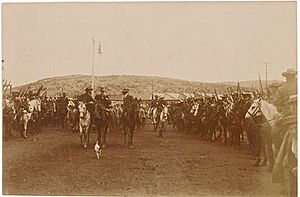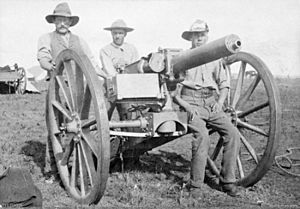Boer commando facts for kids
Quick facts for kids Kommando |
|
|---|---|
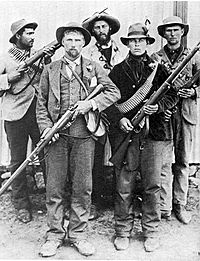 |
|
| Active | 18th century–1902 |
| Country | |
| Branch | Militia |
| Type | Guerilla fighter, Military volunteer |
| Engagements | Boer Wars, Xhosa Wars |
The Boer Commandos or "Kommandos" were volunteer groups of fighters from the Boer people in South Africa. They were like a local defense force or militia. The word "commando" in English comes from these groups during the Second Boer War (1899-1902).
Contents
History of the Commandos
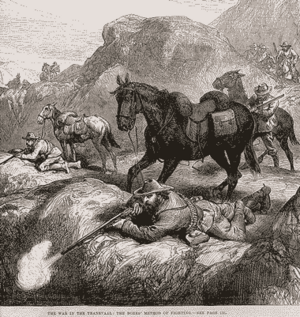
The story of the commandos began in 1658. This was when a war started between the early Dutch settlers at Cape Colony and the Khoi-khoi people. To protect their homes, all healthy men were asked to join the fight. After this war, every man in the colony was expected to be ready for military service at any time.
By the 1700s, the colony had grown much larger. It was split into different areas called districts. The small army at the Castle de Goede Hoop couldn't quickly reach far-off border areas. So, the commando system was made bigger and more official. Each district had a leader called a Kommandant. This leader was in charge of calling up all citizens when needed.
In 1795 and again in 1806, the commandos were called to defend the Cape Colony from the British. At the Battle of Blaauwberg in 1806, the Swellendam Commando held off the British. This gave the rest of the Batavian army time to retreat safely.
Even under British rule, the Cape Colony kept using the commando system. They fought in the Xhosa Wars alongside regular British troops. Boer commandos often fought with Fengu, British settlers, Khoi-khoi, and other groups. These mixed units were often very effective. The light and fast commandos were better suited for fighting in the rough mountains than slow-moving imperial armies.
During the Great Trek, the commando system continued to be used. It stayed important in the Boer republics that were formed. Both republics made laws saying that all male citizens between 16 and 60 had to serve in the commandos when needed. During the Anglo-Boer War (1899–1902), the Boer commando groups were the main fighting force for the Boers.
After the war ended in 1902, the commandos were officially stopped. However, many members secretly formed "shooting clubs" to keep their skills sharp. In 1912, the commandos were brought back as part of the Union Defence Force. This system lasted until 2005, when all commandos were disbanded again.
How the Commandos Were Organized
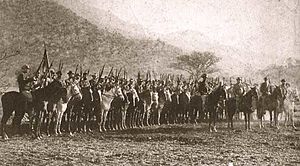
Each commando group was linked to a town and named after it, like the Bloemfontein Commando. Each town was in charge of a district, which was divided into smaller areas called wards. The main leader of a commando was the kommandant. Each ward had a leader called a veldkornet, which was like a senior non-commissioned officer.
The veldkornet had many duties. They called up citizens for service and also acted as police in their ward. They collected taxes and gave out firearms and other supplies during wartime. In theory, a ward was divided into even smaller groups called corporalships. A corporalship usually had about 20 citizens. Sometimes, entire families, including fathers, sons, uncles, and cousins, would make up a corporalship.
The veldkornet reported to the kommandant. The kommandant then reported to a general. A general was usually in charge of four commandos. The general reported to the commander-in-chief of the republic. In the Transvaal, this leader was called the Commandant-General. In the Free State, they were called the Hoofdkommandant (Chief Commandant). The commander-in-chief reported to the president.
Sometimes, extra roles were created during wartime, like the vleiskorporaal ("meat corporal"). This person was in charge of giving out food rations.
The commando was made up of volunteers. All officers were chosen by the commando members themselves, not by the government. This system allowed talented leaders like General Koos de la Rey and General C. R. de Wet to rise. However, it also meant that sometimes less skilled commanders were put in charge. Keeping everyone disciplined was also a challenge, as there wasn't a strong way to enforce rules.
The different Boer republics did not all have the exact same command structure.
Weapons Used by Commandos
Before the Second Boer War, a popular rifle for the republics was the .450 Westley Richards. This rifle was accurate up to 600 yards. It was similar to the Martini-Henry rifles used by British soldiers.
For the Anglo-Boer War (1899–1902), Paul Kruger, the President of the South African Republic, bought new weapons for the army. They imported 37,000 of the latest Mauser Model 1895 rifles. They also bought 40 to 50 million rounds of ammunition for them. The Model 1895 Mauser was also known as the "Boer Model" Mauser. It could shoot accurately over 2,000 yards.
About 7,000 Guedes 1885 rifles were also bought a few years earlier and were used during the war. The Boers also used British rifles they captured, like the "long" Lee-Metford and the Enfield. When their Mauser ammunition ran out, the Boers mainly used these captured Lee-Metford rifles. Very few commandos used bayonets with their rifles.
The Boers also bought modern European artillery. By October 1899, the Transvaal State Artillery had 73 heavy guns. These included four large 155 mm Creusot fortress guns. They also had 25 of the 37 mm Maxim Nordenfeldt guns. The Boers' Maxim gun was larger than the one the British used and became known as the "Pom Pom."
Other weapons sometimes used included:
- Mauser C96 pistol
- Colt Single Action Army revolver
- Remington Model 1875 revolver
- Remington Rolling Block rifle
- Winchester rifle
- Lee–Enfield
- Lee–Metford
- Martini–Henry
See also
- Commando
- Kommando
- Military history of South Africa
- Mounted infantry
- South African Commando System
- First Boer War
- Second Boer War
- Xhosa Wars
- Transvaal Civil War



